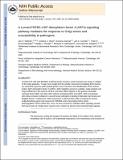A CREB3–ARF4 signalling pathway mediates the response to Golgi stress and susceptibility to pathogens
Author(s)
Reiling, Jan H.; Olive, Andrew J.; Sanyal, Sumana; Carette, Jan E.; Brummelkamp, Thijn R.; Starnbach, Michael N.; Ploegh, Hidde; Sabatini, David; ... Show more Show less
DownloadPloegh_A creb3.pdf (3.455Mb)
PUBLISHER_POLICY
Publisher Policy
Article is made available in accordance with the publisher's policy and may be subject to US copyright law. Please refer to the publisher's site for terms of use.
Alternative title
A CREB3–ARF4 signalling pathway mediates the response to Golgi stress and susceptibility to pathogens
Terms of use
Metadata
Show full item recordAbstract
Treatment of cells with brefeldin A (BFA) blocks secretory vesicle transport and causes a collapse of the Golgi apparatus. To gain more insight into the cellular mechanisms mediating BFA toxicity, we conducted a genome-wide haploid genetic screen that led to the identification of the small G protein ADP-ribosylation factor 4 (ARF4). ARF4 depletion preserves viability, Golgi integrity and cargo trafficking in the presence of BFA, and these effects depend on the guanine nucleotide exchange factor GBF1 and other ARF isoforms including ARF1 and ARF5. ARF4 knockdown cells show increased resistance to several human pathogens including Chlamydia trachomatis and Shigella flexneri. Furthermore, ARF4 expression is induced when cells are exposed to several Golgi-disturbing agents and requires the CREB3 (also known as Luman or LZIP) transcription factor, whose downregulation mimics ARF4 loss. Thus, we have uncovered a CREB3–ARF4 signalling cascade that may be part of a Golgi stress response set in motion by stimuli compromising Golgi capacity.
Date issued
2013-11Department
Massachusetts Institute of Technology. Department of Biology; Whitehead Institute for Biomedical Research; Koch Institute for Integrative Cancer Research at MITJournal
Nature Cell Biology
Publisher
Nature Publishing Group
Citation
Reiling, Jan H., Andrew J. Olive, Sumana Sanyal, Jan E. Carette, Thijn R. Brummelkamp, Hidde L. Ploegh, Michael N. Starnbach, and David M. Sabatini. “A CREB3–ARF4 Signalling Pathway Mediates the Response to Golgi Stress and Susceptibility to Pathogens.” Nature Cell Biology 15, no. 12 (November 3, 2013): 1473–1485.
Version: Author's final manuscript
ISSN
1465-7392
1476-4679